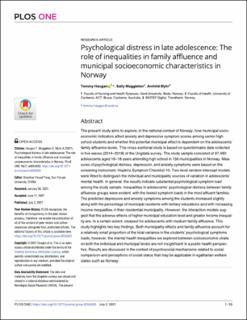| dc.contributor.author | Haugan, Tommy | |
| dc.contributor.author | Muggleton, Sally | |
| dc.contributor.author | Myhr, Arnhild | |
| dc.date.accessioned | 2023-02-13T11:18:09Z | |
| dc.date.available | 2023-02-13T11:18:09Z | |
| dc.date.created | 2021-07-28T21:23:57Z | |
| dc.date.issued | 2021 | |
| dc.identifier.citation | Haugan T, Muggleton S, Myhr A (2021) Psychological distress in late adolescence: The role of inequalities in family affluence and municipal socioeconomic characteristics in Norway. PLoS ONE 16(7): e0254033. https://doi.org/10.1371/journal.pone.0254033 | en_US |
| dc.identifier.issn | 1932-6203 | |
| dc.identifier.uri | https://hdl.handle.net/11250/3050358 | |
| dc.description.abstract | The present study aims to explore, in the national context of Norway, how municipal socioeconomic indicators affect anxiety and depressive symptom scores among senior high school students and whether this potential municipal effect is dependent on the adolescents’ family affluence levels. This cross-sectional study is based on questionnaire data collected in five waves (2014–2018) of the Ungdata survey. The study sample consisted of 97,460 adolescents aged 16–18 years attending high school in 156 municipalities in Norway. Measures of psychological distress, depression, and anxiety symptoms were based on the screening instrument, Hopkins Symptom Checklist-10. Two-level random intercept models were fitted to distinguish the individual and municipality sources of variation in adolescents’ mental health. In general, the results indicate substantial psychological symptom load among the study sample. Inequalities in adolescents’ psychological distress between family affluence groups were evident, with the lowest symptom loads in the most affluent families. The predicted depressive and anxiety symptoms among the students increased slightly along with the percentage of municipal residents with tertiary educations and with increasing income inequalities in their residential municipality. However, the interaction models suggest that the adverse effects of higher municipal education level and greater income inequality are, to a certain extent, steepest for adolescents with medium family affluence. This study highlights two key findings. Both municipality effects and family affluence account for a relatively small proportion of the total variance in the students’ psychological symptoms loads; however, the mental health inequalities we explored between socioeconomic strata on both the individual and municipal levels are not insignificant in a public health perspective. Results are discussed in the context of psychosocial mechanisms related to social comparison and perceptions of social status that may be applicable in egalitarian welfare states such as Norway. | en_US |
| dc.language.iso | eng | en_US |
| dc.publisher | PLOS | en_US |
| dc.rights | Navngivelse 4.0 Internasjonal | * |
| dc.rights.uri | http://creativecommons.org/licenses/by/4.0/deed.no | * |
| dc.title | Psychological distress in late adolescence: The role of inequalities in family affluence and municipal socioeconomic characteristics in Norway | en_US |
| dc.type | Peer reviewed | en_US |
| dc.type | Journal article | en_US |
| dc.description.version | publishedVersion | en_US |
| dc.rights.holder | Copyright: © 2021 Haugan et al. This is an open access article distributed under the terms of the Creative Commons Attribution License, which permits unrestricted use, distribution, and reproduction in any medium, provided the original author and source are credited. | en_US |
| dc.source.pagenumber | 1-25 | en_US |
| dc.source.volume | 16 | en_US |
| dc.source.journal | PLOS ONE | en_US |
| dc.source.issue | 7 | en_US |
| dc.identifier.doi | 10.1371/journal.pone.0254033 | |
| dc.identifier.cristin | 1922919 | |
| cristin.ispublished | true | |
| cristin.fulltext | original | |
| cristin.qualitycode | 1 | |

